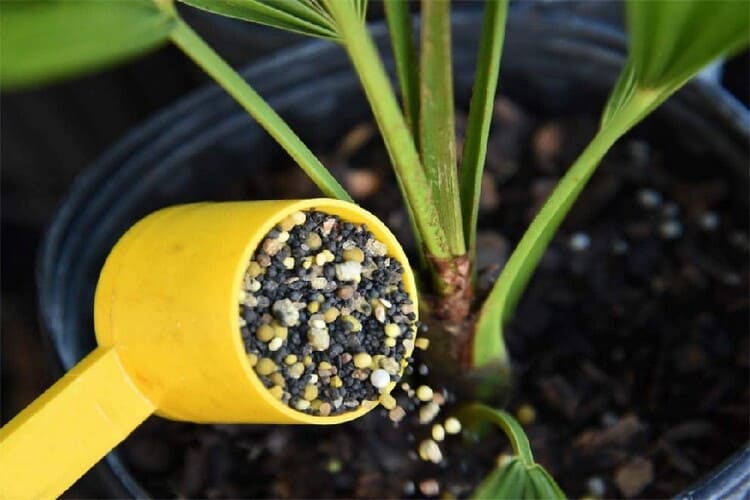How Do You Fertilize Citrus Trees? 6 Tips For Thriving

Citrus, like other plants, requires nutrients to thrive and yield an abundant supply of fruit. But, how do you fertilize citrus trees?
The method of fertilization depends on the type of fertilizer you are using. You can follow some tips to optimize your crop, such as determining the appropriate quantity of fertilizer for each application. In this article, FlowerBedNursery will provide you with tips and tricks on how and when to fertilize your citrus fruit tree.
How Do You Fertilize Your Citrus Tree?
The method of fertilizing your citrus plants depends on the type of fertilizer you use. Some ask you to spray on the leaves, while others require fertilizer to be applied to the soil.
It is recommended to follow the guidelines on the fertilizer package for the best fertilization method. Here are some common tips to try for the best result:
- Avoid applying fertilizer to newly planted citrus trees during the first year. Newly planted trees should be allowed to establish themselves in the soil for one year before applying fertilizer.
- Water the soil before fertilizing and after applying fertilizer.
- Divide the total amount of fertilizer your plant needs for the year into multiple applications throughout the year.
- If you are uncertain about the quantity, it is better to use slightly less fertilizer than you think you will need. Over-fertilizing can cause fertilizer burn.
- Adjust the amount of fertilizer based on the size and needs of each citrus tree.
- Distribute granular fertilizer all around the tree’s base, slightly beyond the drip line. Then, drag the top several inches of dirt using a rake.
Get the most out of your citrus trees with this fertilizer pro-tip video:
What Kind Of Citrus Fertilizer Does Your Citrus Tree Need?
An N-P-K treatment with micronutrients is essential for your crop. The nutrients include copper, zinc, boron, iron, and manganese. Citrus prefers mildly acidic soil. Hence, make sure the fertilizer you choose is appropriate for your plant to guarantee a balanced diet.
Fertilizers for your crop are available in a variety of types, such as organic and chemical. They come in sprays, granules, and spikes.
Sprays
The concentrations are usually intense. You have to mix them with water before using them. Read the label for directions on how to dilute the solution and apply it. Remember, sprays are suitable for all types of citrus trees, including miniature citrus trees.
Granules
There is no need to dilute or combine the granules with anything else. You can sprinkle them on the topsoil or dig them in. Depending on the size of the citrus tree, follow the directions on the product’s label to determine how much granular fertilizer you’ll need.
Spikes
These treatments are the easiest for busy gardeners. They save a lot of time and effort. However, the price is somehow higher than the others. The spikes are pre-measured. All you have to do is stick them into the soil.
When To Fertilize Citrus Trees In Pots?
Fertilize citrus trees once every one or two months during periods of active growth (often spring and summer) and once every two or three months during dormant times (often fall and winter). During this time, citrus trees need additional nitrogen, so try to find products that add this doubled nutrient. As a result, you need to fertilize your citrus three times a year.
When Should You Not Fertilize The Citrus Trees?
You may reduce or skip fertilizer during the dormant period as the citrus tree grows older. You can also extend the duration between active growth fertilization to every three months. To determine the ideal time frame for fertilizing, you need to consider your plant’s growth and physical appearance.
This kind of citrus tree is most nutrient-hungry when it blooms. It would help if you fed it well until it had solidly set fruit.
No matter how healthy your citrus tree is, apply fertilizer when it is in bloom.
Limiting fertilization is necessary in these cases:
- Mature and healthy citrus trees.
- Trees are holding onto fruits.
When citrus trees look robust, feeding them too much can cause them to yield poor fruit.
How Do You Naturally Fertilize The Citrus Trees?
Try using organic fertilizer to enrich both your soil and citrus trees instead of synthetic ones.
Here are some steps to naturally fertilize your citrus trees:
- Add some grass trimmings to provide nitrogen to the soil.
- Remove any debris from the tree’s bottom and scatter the clippings on the topsoil.
- Put compost over the topsoil around your citrus trees for more nutrients.
- Sprinkle about 2 inches of citrus fertilizer around the citrus trees, but keep it about two inches away from the stem to prevent bark erosion.
You may make compost by yourself by putting leaves, clippings, tiny twigs, and mulch in a specified spot and allowing them to break down.
Conclusion
We can’t deny the significance of fertilization. If you are cultivating citrus, consider thoroughly when and how to feed your crop. Otherwise, it will suffer some illnesses and fail to produce a plentiful yield.
Hopefully, you will find this article helpful. If you need any further information, please feel free to ask. Thank you for reading!
Related post:









